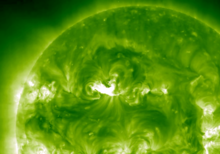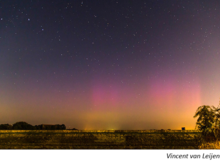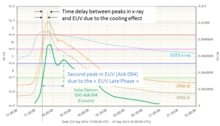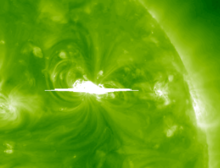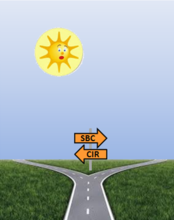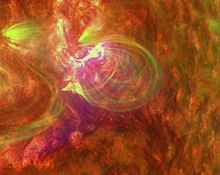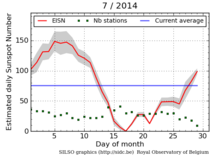news
Submitted on 2014-10-08
Last week's highlight certainly was the M7.3 flare that was produced by the sunspot complex NOAA 2172/2173. This flare peaked on 2 October at 19:01UT, and was preceded by a long duration M1.5 flare peaking at 17:44UT in the same area near the southeast solar limb.

Submitted on 2014-09-14
On 10 September at 17:45UT, NOAA 2158 produced the 35th X-class flare of the ongoing solar cycle. The X1.6 event was extensively covered in this news item. The images underneath show the sunspot region in white light and the corresponding magnetogram about 30 minutes prior to the flare's peak, and the flare at its maximum flux as observed in SDO/AIA 171. The flare took place along the borderline between negative (blue) and positive (red) magnetic polarity.
Submitted on 2014-09-14
On 1 September around 11:05UT, the STEREO-B spacecraft observed a huge blast on the farside of the Sun (see this movie). The maximum strength of the flare was cautiously estimated to be between M5 and X1.5, giving it a good chance the event belonged to the category of "eXtreme" flares.

Submitted on 2014-09-03
This movie shows the development of a magnetic delta near the initially simple sunspot group NOAA 2146, starting on 23 August. One can indeed see how a white patch (positive polarity, field lines coming out of the solar surface) gradually shaped itself south of the main spot (black, negative polarity). Then, late on 24 August, the penumbra of both spots merged and gave NOAA 2146 a delta configuration.

Submitted on 2014-08-13
Remember NOAA 2126? This relatively small sunspot group was visible from about 23 July till 3 August. It was flanked to the north and south by resp. NOAA 2129 and NOAA 2123, which were smaller and simpler sunspot groups. During its transit, NOAA 2126 produced only a few small C-class flares.

Submitted on 2014-08-06
Solar filaments are clouds of ionized gas above the solar surface squeezed between magnetic regions of opposite polarity. Being cooler and denser than the plasma underneath and their surroundings, these magnetic borderlines appear as dark lines when seen on the solar disk using special filters. As filaments grow longer, they are more likely to erupt, often accompanied by a coronal mass ejection (CME).

Submitted on 2014-07-31
The Sun had its own mountain stage this month, with soaring sunspot numbers during the first week, then a fast decline until sea-level values (that is: zero sunspots) were reached on the 17th, followed by a gradual recovery to more moderate sunspot numbers. This can be seen in the evolution of the estimated daily sunspot number as compiled by SILSO, and shown in graph underneath.

Pages
Zircon - This is a contributing Drupal Theme
Design by
WeebPal.



